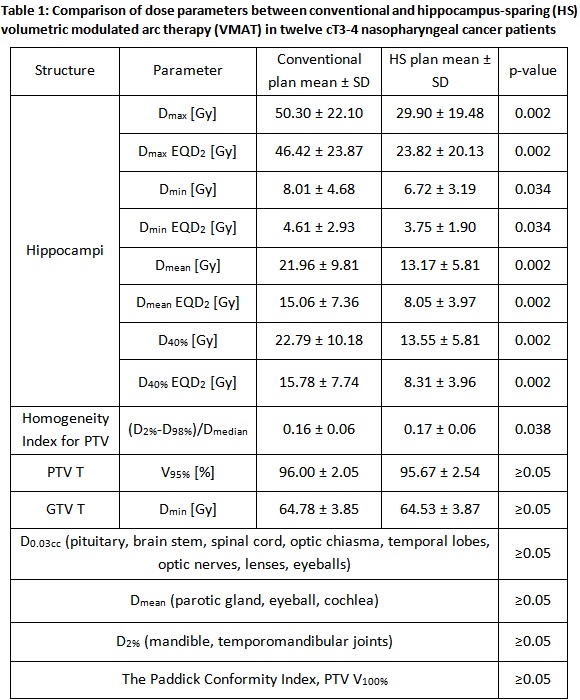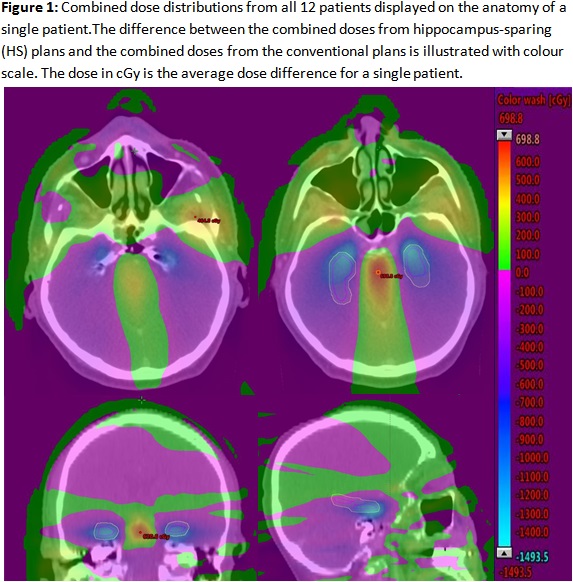Dosimetric comparison of conventional and hippocampus-sparing VMAT plans in nasopharyngeal carcinoma
Monika Peternel,
Slovenia
PO-1219
Abstract
Dosimetric comparison of conventional and hippocampus-sparing VMAT plans in nasopharyngeal carcinoma
Authors: Monika Peternel1, Gaber Plavc1, Primož Strojan1, Aljaša Jenko2, Larisa Petrovič2
1Institute of Oncology, Division of Radiotherapy, Ljubljana, Slovenia; 2Institute of Oncology, Department of Radiophysics, Ljubljana, Slovenia
Show Affiliations
Hide Affiliations
Purpose or Objective
Radiation treatment (RT) of patients with nasopharyngeal carcinoma (NPC) may lead to cognitive decline. Damage to the hippocampi appears to play a considerable role. The purpose of this in silico study was to evaluate whether using hippocampus-sparing (HS) volumetric modulated arc therapy (VMAT) allows for appropriate target volume coverage without compromising other organs at risk (OAR) dose constraints as defined in the 2019 international recommendations.
Material and Methods
Twelve patients with cT3-4 NPC treated with VMAT technique at the Institute of Oncology Ljubljana, Slovenia, between 6/2017 and 12/2021 were included. Patients were scanned on a CT and an MR simulator and CT-MR fusion scans were used for contouring. The dose prescribed to the high-dose PTV was 70 Gy in 35 fractions. Induction chemotherapy was allowed (six patients). OARs were contoured according to the international guidelines. Hippocampi were contoured according to the hippocampal contouring atlas from the RTOG 0933 study. One conventional and one HS VMAT plan with simultaneously integrated boost were created for every patient. Dosimetric restrictions used for the hippocampi were EQD2 equivalents (α/β =2 Gy) from the NRG-C001 study protocol: D100% ≤ 11.2 Gy (Dmin) and D0.03cc ≤ 21.9 Gy (Dmax). Dose prioritization and acceptance criteria were applied according to the latest international guidelines from 2019. Hippocampi were added as number 3 priority. In HS plans the focus was on lowering the dose to the hippocampi as much as possible while taking the dose constraints and recommendations for all other parameters with higher priority into account. Wilcoxon signed-rank test was used for the statistical comparison of the DVH parameters between conventional and HS plans.
Results
Statistically significant differences (p<0.05) between conventional and HS plans were achieved in the following parameters: hippocampal Dmax, Dmin, Dmean and D40% (Table 1). We found no significant differences in PTV V100%, PTV V95%, the Paddick Conformity Index for PTV, and doses to OARs, though at the expense of less homogenous PTV coverage in HS plans (p=0.038) (Table 1). The average dose redistribution in HS VMAT plans as compared to conventional VMAT plans is illustrated in Figure 1.


Conclusion
HS VMAT does not compromise target volume coverage in RT of NPC and could potentially reduce long term cognitive decline in NPC patients. We propose its inclusion in RT planning protocols for NPC treatment.